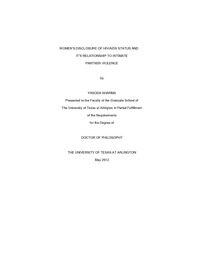
ATTENTION: The works hosted here are being migrated to a new repository that will consolidate resources, improve discoverability, and better show UTA's research impact on the global community. We will update authors as the migration progresses. Please see MavMatrix for more information.
Show simple item record
| dc.contributor.author | Sharma, Yasoda | en_US |
| dc.date.accessioned | 2014-03-10T21:17:46Z | |
| dc.date.available | 2014-03-10T21:17:46Z | |
| dc.date.issued | 2014-03-10 | |
| dc.date.submitted | January 2012 | en_US |
| dc.identifier.other | DISS-11782 | en_US |
| dc.identifier.uri | http://hdl.handle.net/10106/24057 | |
| dc.description.abstract | The purpose of this cross-sectional survey study is to examine the frequency and severity of physical, sexual and emotional intimate partner violence (IPV) experienced by women before and after diagnosis of HIV/AIDS. This research also examines the effect of social support on the IPV experienced by these women. During the fall of 2011, women living with HIV/AIDS and receiving services from AIDS Outreach Center located in the southwestern part of the United States were recruited to participate in a study through the purposive sampling method. They were asked to complete surveys about their HIV/AIDS diagnosis, disclosure, level of IPV experienced, and their level of social support. Sixty-four women completed the survey.The majority (51.6%) of the research participants were African-Americans with a mean age of 46. Many women in the study were separated/divorced (34.4%); 29.7 % were married and 12.5% were cohabiting. Almost all the women (93.2%) had disclosed their HIV status to their current intimate partner and majority (71.9%) of the women`s partners were HIV negative. The majority of the research participant reported experiencing all forms of IPV before their diagnosis of HIV/AIDS. Most women (71%) reported experiencing emotional abuse, 53% reportedphysical abuse, and 52% reported sexual abuse. Significantly more women reported experiencing IPV after their diagnosis of HIV/AIDS (71% emotional abuse, 61% physical and 53% sexual abuse).There was a statistically significant difference [t (63) = -2.57, p = 0.013] in the frequency of physical IPV experienced by women before (M=18.34, SD= 26.79) and after (M=26.68, SD=34.06) the diagnosis of HIV/AIDS. Similarly, there was a statistically significant difference [t (63) = -2.08, p = 0.041] in frequency of sexual IPV experienced by women before (M=5.43, SD= 6.41) and after (M=6.92, SD=7.98) the diagnosis of HIV/AIDS. The severity of all types of IPV experienced by women also significantly increased following HIV/AIDS diagnosis. The severity of physical violence [t (63) = -2.76, p = 0.008] sexual violence [t (63) = -2.34, p = 0.022] and emotional violence [t (63) = -2.54, p = 0.014] significantly increased following HIV/AIDS diagnosis.Social support significantly predicted severity of physical, violence (â = -.57, p<.01) and sexual violence (â = -.16, p<.01) experienced by women living with HIV/AIDS before the diagnosis of their HIV/AIDS status. Social support (â = -.206, p<.05) significantly predicted severity of emotional violence experienced by women after the diagnosis of HIV/AIDS. Partner`s HIV status did not significantly predict the frequency and severity of physical, sexual and emotional IPV among women living with HIV infection before or after the diagnosis.This research emphasizes the importance of teaching social work students about theco-occurrence of IPV and HIV/AIDS and how women`s risk of all forms of IPV increases following diagnosis of her HIV/AIDS status. Social work educators can also help students better understand the role of the social support on the lives of women who experience IPV before and after a HIV/AIDS diagnosis. | en_US |
| dc.description.sponsorship | Black, Beverly M. | en_US |
| dc.language.iso | en | en_US |
| dc.publisher | Social Work | en_US |
| dc.title | Women's Disclosure Of HIV/AIDS Status And It's Relationship To Intimate Partner Violence | en_US |
| dc.type | Ph.D. | en_US |
| dc.contributor.committeeChair | Black, Beverly M. | en_US |
| dc.degree.department | Social Work | en_US |
| dc.degree.discipline | Social Work | en_US |
| dc.degree.grantor | University of Texas at Arlington | en_US |
| dc.degree.level | doctoral | en_US |
| dc.degree.name | Ph.D. | en_US |
Files in this item
- Name:
- Sharma_uta_2502D_11782.pdf
- Size:
- 3.753Mb
- Format:
- PDF
This item appears in the following Collection(s)
Show simple item record


